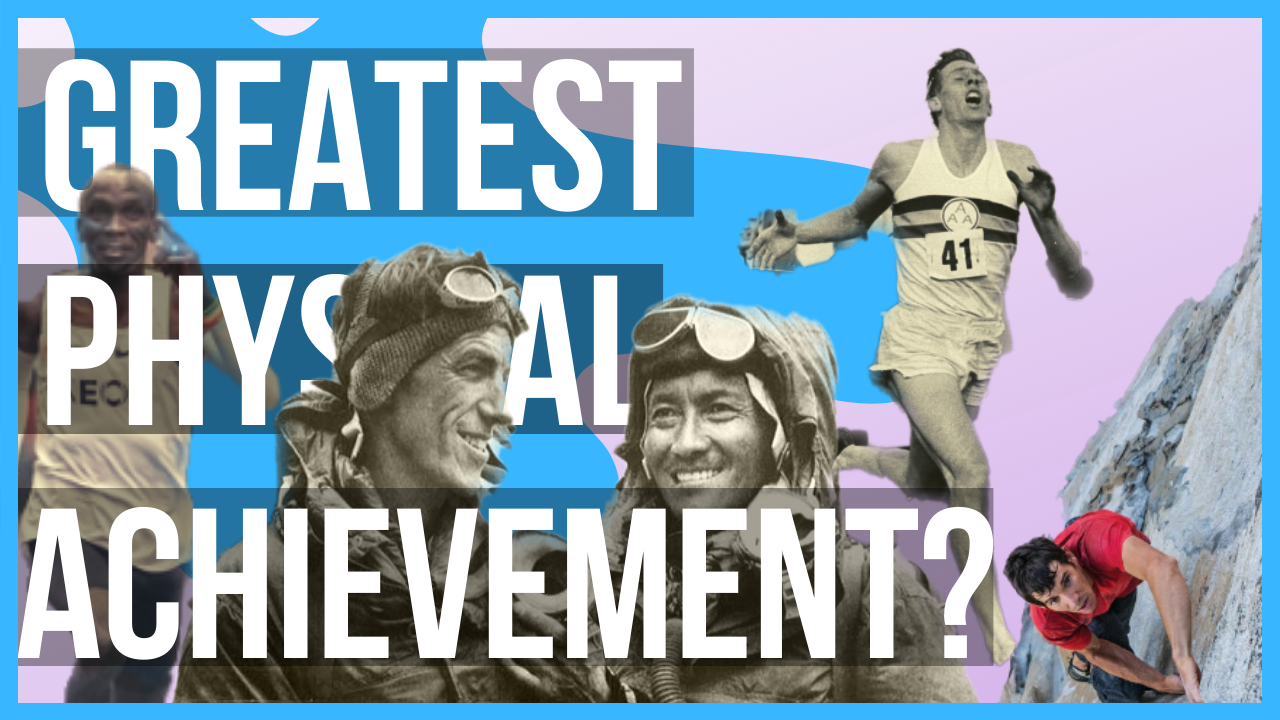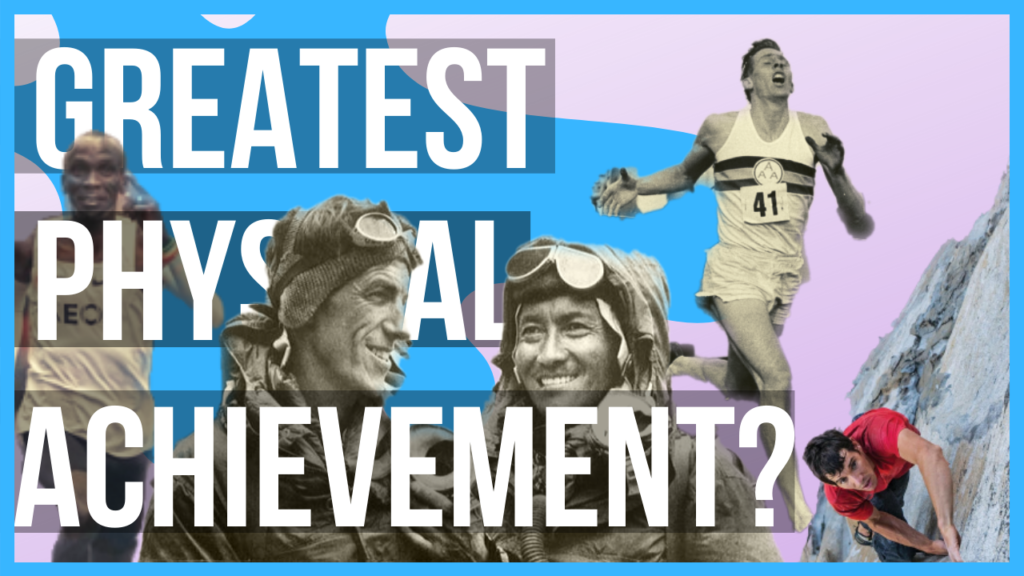To watch the video on YouTube, click here.
In 2019, the world watched and celebrated Eliud Kipchoge do something no human had ever done before: run a sub-2 hour marathon.
But that got me thinking: We humans often do great things that push the limits of what we think is possible so, what is the greatest physical sporting achievement of all time?
The Contenders
In this video, we’re going to only argue about physical sporting achievements. Great human achievements like landing on the moon, mapping the human genome, or the development of agriculture are covered in a different video.
And let’s be clear: there are a ton of remarkable physical sporting achievements. But here are the four we’ve chosen for the argument today:
Sir Edmund Hillary and Tanzing Norgay’s first-ever summit of Mount Everest, Roger Bannister’s breaking of the 4-minute mile, Eliud Kipchoge’s breaking of the 2-hour marathon, and Alex Honnold’s free solo climb of El Capitan.
In Argue About It Fashion, we’re going to first give you an overview of each, then determine the winners based on the “Big Three.”
For today’s argument, the Big Three are:
(1) Physical achievement,
(2) Mental side of the physical achievement,
(3) and, of course, the “X” Factor
First up, Sir Edmund Hillary and Tenzing Norgay’s summit of Mount Everest.
Yes, mountaineering is considered a sport by the Encyclopedia Britannica and on May 29th, 19530 arguably the greatest accomplishment in Mountaineering was achieved: the first confirmed Summit of the highest point on planet earth — Mount Everest.
On that date, New Zealand mountaineer, explorer, and philanthropist Edmund Hillary and Tenzing Norgay became the first climbers confirmed to have reached its 29,029ft summit.
A little history: Since it was announced in 1856 that Peak XV (as Everest was known back then) was the tallest mountain in the world at just over 29,000 ft. , explorers had tried to conquer it.
And since then, it has captivated the climbing world.
While the climb itself does not pose substantial technical rigor, it does have the dangers of altitude sickness, unpredictable weather, extreme wind, and deadly avalanches. It’s for this reason that people still die each year trying to reach the summit.
But the dangers never stopped explorers from trying.
So, in 1953, as part of a larger expedition, it was Edmund Hillary and Sherpa guide Tenzing Norgay that endured the weather, frozen gear, low oxogen, and dangerous terrain to finally become the first to navigate a way to the top of Everest. As would come out years later, it was Hillary that actually took the first steps onto Everest’s peak.
What do you do at the top of Everest? Good question: They spent about a total of 15 minutes at the top, taking pictures of the surrounding mountainside; Hillary left a cross and Tenzing left chocolates at the summit; and then started down the mountain.
Next, is Eliud Kipchoge’s sub – 2-hour marathon.
On October 12, 2019, 34 year-old Eliud Kipchoge became the first man in history to run a sub-2 hour marathon, in a time of 1 hour 59 minutes and 40 seconds.
Well, sort of.
You see, the IAAF (International Association of Athletics Federation) doesn’t actually recognize the feat as being a true marathon.
Kipchoge did run 26.2 miles, the distance of a marathon; however, because he had outside support from pacers, a pace car, and even hydration helpers on bicycles who would meticulously track his fluid intake throughout the race, the feat is not recognized by the IAAF.
But with that said, Kipchoge’s feat is an example of what is possible, irregardless of whether or not it is recognized by a sports federation.
Here’s what I mean:
One study developed a model of marathon performance to answer the question of what the hard limit minimum time a human body with optimal strength, efficiency, and corse considerations might be able to achieve. The results: 1 Hour 57 minutes and 58 seconds. That’s it. That’s the limit of human capacity they said. They also predicted that for someone to achieve this time, they should be small in stature, exposed to high altitudes, and significant physical activity since childhood.
While Kipchoge’s time didn’t match the “hard limit” set by the study, it came darn close at 1 hour 59 minutes and 40 seconds. Sure, he had help and tried to plan the optimal conditions possible to achieve the feat — but he nearly met what science said is the limit of human achievement in running that distance.
If you view the challenge of the sub-2 hour marathon as a test of what humans are physically capable of, then this checks all the boxes for one of the greatest physical sports achievements ever.
Third, we have Roger Bannister sub-four minute mile in 1954.
Like the sub-2 hour marathon, the sub-four minute mile was an athletic feat that seemed impossible — until it was broken by Roger Bannister on May 6th, 1954 with a time of 3:59.4.
In fact, in 1954 over 50 medical journals stated that the 4 minute mile could not be broken.
The race to break the 4 minute mile mark was popularized in the 1930s alongside the popularization of newsreels and the Great Depression.
During that time, stars were made out of milers trying to break the 4 minute mile. Jules Ladoumegue (Led-oo-Meg) in France, Jack Lovelock in New Zealand, and Glenn Cunningham in the United States were all in the world spotlight, and the 1500 meter run was one of the most anticipated events of the 1936 summer olympic, where a world record was set.
Now, runners all had their own approaches to achieving the sub-4 minute mile: Some started faster and tried to give everything they could throughout the entire race, others started slower and hoped to save enough energy to be in a dead sprint near the finish line. Bannister chose to break the race into four separate mini-races and maintain an even pace through the first 3 laps around the track, after which, he would give it everything he had for the final 300 meters of the race.
The plan worked for him and in on May 6th, 1954, Roger Bannister was clocked at 3:59.4 — becoming the first person to have confirmed having run a sub 4 minute mile.
For this feat, Sports Illustrated even named Roger Bannister their first-ever Sports Illustrated Sportsman of the Year.
Lastly, let’s look at Alex Honnold’s Free Solo of El Capitan
In the rock climbing world, the center of the universe is El Capitan — a vertical rock formation in Yosemite National Park in California. It has numerous routes that climbers take to reach the top, but in 2017, climber Alex Honnold decided he would climb the 2,900 foot Freerider route alone — without protective equipment.
This is known as “Free Soloing” and it involves climbing rock faces without any ropes or technical gear: Just you, your climbing shoes, and climbing chalk bag. That’s it.
If you fall, you die. Plain and simple.
But that didn’t stop Alex Honnold from doing what no one else had previously done before.
In fact, 31 climbers have died since 1905 climbing El Capitan either with or without ropes.
In fact, on the record, there were only two other people in the world who were thinking about the possibility of free soloing El Capitan — both of them died in accidents before they could make an attempt. The greatest free soloist of the 1970s, John Bachar (pronounced BACKER), didn’t consider it.
Neither did Peter Croft, who did free soloed a smaller climb in Yosemite in the 1980s. It was something people had only speculated might be attempted, and no one thought it would actually be done.
Until Alex Honnold did it in 2017.
2,900 feet.
3 hours and 56 minutes from bottom to top.
Without ropes to protect him if he fell.
And what National Geographic called the “Moon landing of Rock Climbing.
The New York Times even called it “One of the greatest athletic feats of any kind ever.”
BIG 3 ANALYSIS
So let’s break this down according to the “Big Three”
-Physical Difficulty
-Mental Difficulty
-“X” Factor
First, Physical Achievement:
Each of these feats took extraordinary physical ability.
But when awarding points to each endeavor, I think it is safe to put Climbing Everest as the least physically strenuous. Which, sounds totally crazy to say, but we are talking about the greatest physical sporting achievements, after all.
Yes, the altitude is a huge hurdle to overcome — but Hillary and Tenzing overcame it with periods of acclimating themselves to the high altitude and using oxygen tanks to overcome low oxygen levels.
Their difficulty was more “How to get up Everest” than “are we physically in shape enough to get up Everest” and since this is a physical achievement category, they receive 1 point.
Running a sub-4 minute mile is a physically demanding achievement; and even though it had never been confirmed to have been accomplished prior to Bannister’s achievement in 1954, it has since been achieved over 1,400 times, by runners from high school age to over 40 years old. Actually, the world record now stands at 3:43, a full 16 seconds under the mark set by Bannister.
Additionally, in 1997 Daniel Komen of Kenya ran two miles in less than 8 minutes, which you could argue (and I hope you do!) is doubling the accomplishment of a sub-4 minute mile. None of this is not to diminish what Bannister achieved, he was the first after all, but it does indicate that human capacity goes well beyond Bannister’s achievement. 2 points for Bannister.
Between Kipchoge’s sub-2 hour marathon and Honnold’s free solo climb of El Capitan it is close on which one is the greater physical feat. Spending nearly four hours on a granite rock face, holding on literally for dear life as you push and pull your way up 3,000 feet is remarkable. But so is the ability to push the pace of a marathon to 4:34 minutes per mile… for 26.2 miles! Hop on a treadmill and try that sometime (*Disclaimer — I’m not actually advocating you try that!). In fact, as I mentioned earlier, science postulates that humans with optimal biomechanics and environmental conditions will only be able to go some two minutes faster and that! That is it! A hard limit on how fast a marathon can be run will be set at 1 hour and 57 minutes.
But Kipchoge did have help. And that is important.
The course was selected for its ideal conditions for breaking the sub-two hour marathon.
Prater Park in Vienna had the ideal temperature, humidity, wind speed, and elevation based on a world-wide search using technical software to analyze these factors. Kipchoge also had 42 pacemakers, some of the best runners in the world, to help him stay on pace.
And, talking about pace, he had an electric pace car with a laser that was projected onto the road to help maintain the pace throughout the entire run.
This is not to take anything away from Kipchoge — even researchers who crunched data on if what he did was going to be possible thought that the feat would not be reached until at least 2032,
But even though Kipchoge’s physical achievement was significant, the ability of Alex Honnold to climb for nearly 4 hours — essentially holding, pulling, and pushing nearly continuously — at the cost of his life if his physical fitness failed him, puts what he did in a category of its own.
Yes, he needed to be in remarkable physical shape, but he also had to make sure that on the day of the performance, that physical shape did not fail even a little bit. He didn’t have any help on the wall either. He only had himself to rely on. No one else. For that, for his years of training and ability to trust himself and his fitness, Honnold gets the 4 points.
Second is the Mental Aspect of Their Physical Achievement.
It is impossible to deny the mind-body connection in these achievements.
Yes, your body needs to be ready to achieve at high levels, but your mind has to be able to endure the punishment too. You can’t quit, not even for a second, especially when it could cost you the record on the track, or your life on a mountain or rock face.
And, of course, doing something that has never been done before comes with its own mental toughness. Each of these achievements was accomplished despite people thinking it couldn’t be done — yet they all did it.
With the 1 point, I’m awarding it to the Roger Bannister’s sub-four minute mile.
Bannister had two pace makers help him to achieve his goal, and Bannister himself knew that if he just pushed himself for those 3 minutes and 59 seconds, if he endured the pain of the pace set by his pacemakers, he would be able to get the record.
That’s also why I’m awarding the two points to Kipchoge. He had help, and he knew if he could hold on and endure that grueling pace for 1 hour and 59 minutes, if he could focus on the pace car or the pace setters, he could achieve the record. And so, Bannister and Kipchoge both did just that: they ground it out and shifted their focus to their partners or the pace or both.
Hillary and Tenzing were different: they could have died.
Actually, they could have died very easily attempting to summit Everest. Mentally, if they freaked out or made just a small mistake, their life was on the line.
Prior to them, plenty of people had died trying to summit Everest because they had picked the wrong route, or the wrong day, or planned for the wrong environment.
But Hillary and Tenzing were able to stay focused on the goal, and were able to come up with contingency plans as they needed them to make summiting Everest possible.
For example, to get to the top, Hillary created his own path by improvising and maneuvering up a rock face now known as the Hillary Step. He and Tenzing didn’t know how they were going to climb it prior to arriving at it, and that’s where it took their mental toughness, composure, and creativity to complete the climb and summit. For that, the Hillary and Tenzing summit get’s 3 points.
Alex Honnold’s mental toughness is difficult to rate, but I’m going to think the best of him. What he did, with the composure and focus necessary to climb 2,900 vertical feet of granite is amazing. Yes, he had to keep his composure… or he’d die; yes, he had to keep his focus entirely on what he was doing for the duration of the climb… or he’d die; and yes, he had to creatively solve any problems independent of outside help… or he’d die; But he also had to plan the route and have enough technical knowledge about the wall to see his free solo climb through.
The Atlantic put it this way in an article on his feat: “Most people face challenges, but worrying about free-falling thousands of feet down a mountain if you misplace a single digit is not one of them.” The mental toughness to block out absolutely everything, while maintaining a state of flow to achieve something that had never been done before … or else you’d die… is why gets Alex Honnold 4 points.
And at last, the X FACTOR
Okay, Okay, all of these achievements are remarkable, and who am I to sit back and judge any of them; however, I’m giving the X factor points to Alex Honnold. Everyone else gets one point. Here’s why:
Since Hillary and Tenzing found a way up Everest, today, nearly 500 people summit every year.
Since Bannister broke the 4 minute mile, it has been broken over 1,400 times.
Eliud Kipchoge’s sub-2 hour marathon is remarkable, but there are currently several runners who are within seconds of breaking the two-hour mark.
Alex Honnold’s free-solo climb of El Capitan is something that no one has ever done before, and something that may not ever be even ATTEMPTED, yet achieved, again because of the sheer danger of free-solo climbing. It is something so remarkable, so crazy even, that it is in a league of its own. For that, he gets the 4 points.
THE WINNER:
So in the end, Alex Honnold’s free-solo of El Capitan is arguably the greatest physical achievement ever.
And something we’ll put him in the winner’s bracket for in our 2020 March Madness Arguments.
But what do you think?
Leave us a voice message at the link below or comment your thoughts in the comment section below.
We review listener feedback on our podcast, Argue About it, and give away prizes for the most convincing arguments, and counter arguments you all make.
That’ll do it for this episode. We’ll see you in another argument, and until then remember: play nice.
Sources, Image and Video Attribution:
– By Denis Barthel – Own work, CC BY-SA 4.0, https://commons.wikimedia.org/w/index.php?curid=72802002
– By Eckhard Pecher (Arcimboldo) – Own work, CC BY 2.5, https://commons.wikimedia.org/w/index.php?curid=2656519
– 8 Amazing https://www.lifehack.org/490292/8-amazing-human-achievements-to-inspire-you
– JED LEICESTER / AP Kipchoge image
– Hard limit on marathons: https://www.sciencemag.org/news/2019/06/study-marathon-runners-reveals-hard-limit-human-endurance
– https://www.scientificamerican.com/article/how-fast-can-a-marathon-be-run/– Hillary Step: By Debasish biswas kolkata – This file was derived from: Hillery Step near Everest Top.JPG, CC BY-SA 4.0, https://commons.wikimedia.org/w/index.php?curid=67605322
-By Rdevany at the English Wikipedia – File:Mt. Everest from Gokyo Ri November 5, 2012.jpg, CC BY-SA 3.0, https://commons.wikimedia.org/w/index.php?curid=23335979


